The ASUS Republic of Gamers G751 Review: G-SYNC Comes To The Notebook Computer
by Brett Howse on July 29, 2015 8:30 AM ESTSystem Performance
To start on the performance section, let’s take a look at how the ASUS G751 performs when running applications on the desktop. Powering the ASUS G751 model that was shipped for review is the Intel Core i7-4720HQ processor. At this point in the life of the fourth gen Core i7 processors, it may seem out of date, but the i7-4720HQ was actually just launched in Q1 2015. It is a quad-core, eight-thread processor with a base frequency of 2.6 GHz and turbo of 3.6 GHz. The maximum turbo is held in check by the 47 watt thermal design point, which is at the top end of the mobile processor range from Intel. It would have been nice to see ASUS move to Broadwell, but the quad-core mobile parts will likely be short lived anyway and have certainly been a long time coming.
With 24 GB of memory, the dual-channel memory is not balanced, with 8 GB on one channel and 16 GB on the other. ASUS does offer a model with a full 32 GB, or you can always order another stick of DDR3L-1600 if you want to change that. But as we will see in the scores below, performance is not impacted by this very much if at all, especially since the bandwidth-hungry iGPU is going unused.
Storage is a strong point on the ASUS G751, with ASUS being one of the first companies to start moving to PCIe based SSDs. The XP941 can achieve speeds over 1 GB/s, and while it has been surpassed by the Samsung SM951, it’s still a solid and quick PCIe SSD.
To take a look at general performance, the G751 was put through our laptop workloads. The graphs include other similar devices for comparison, but if you would like to compare the G751 against any other device we have tested, please check out our Notebook Bench.
PCMark
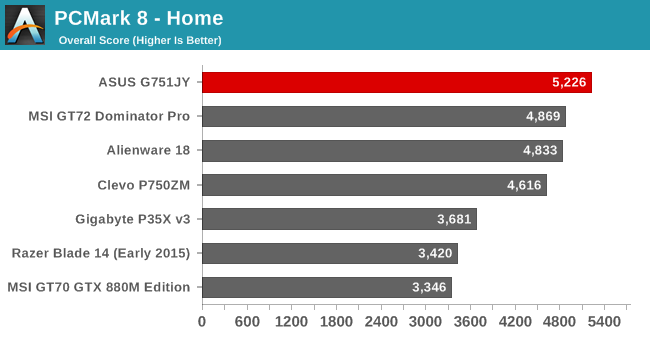
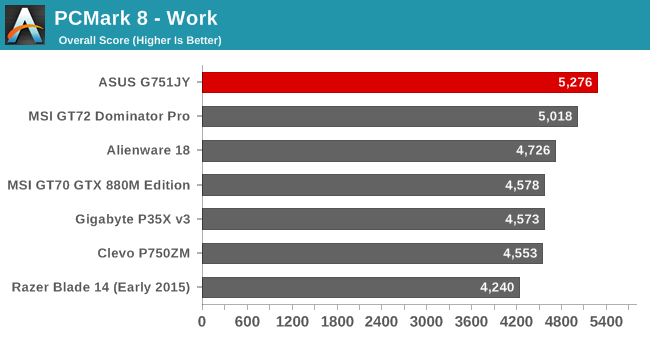

PCMark attempts to replicate real life workloads, and has several different tests which focus on specific workloads. The G751 performs very well in these tests, scoring the highest of any notebook we’ve tested. Since this is a comprehensive benchmark, the CPU is part of the equation, but so is the GPU, display resolution, and storage speed. ASUS has created a pretty well rounded notebook here.
Cinebench
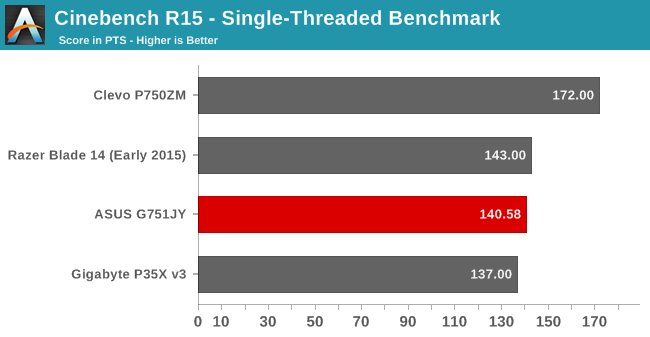
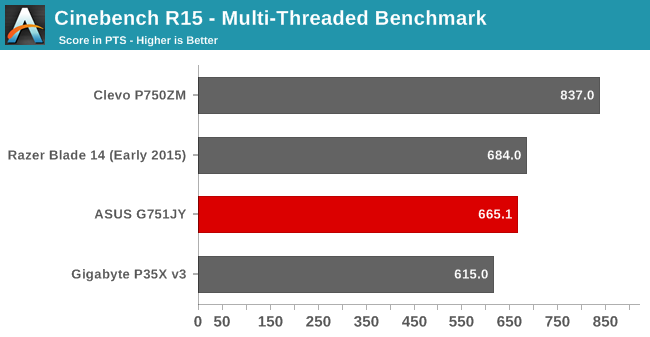
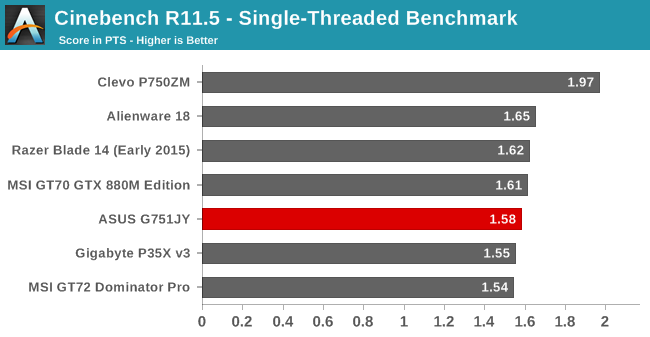
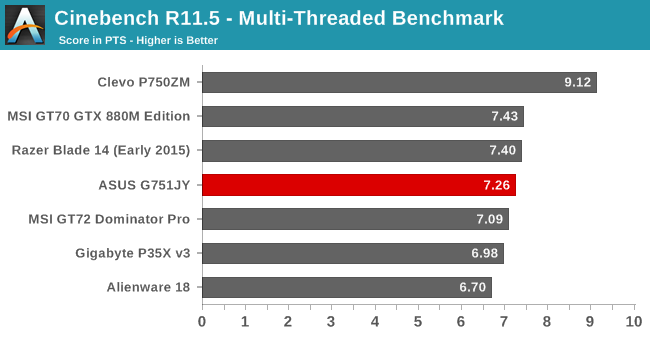
Cinebench tests the ability for the CPU to render an image, and it loves high frequencies and plenty of instructions per clock. The Core i7-4720HQ is fairly powerful in this test, and falls in line with scores similar to other notebooks that have a similar processor. The Clevo has a desktop class 88 watt processor, and runs away in this benchmark.
x264
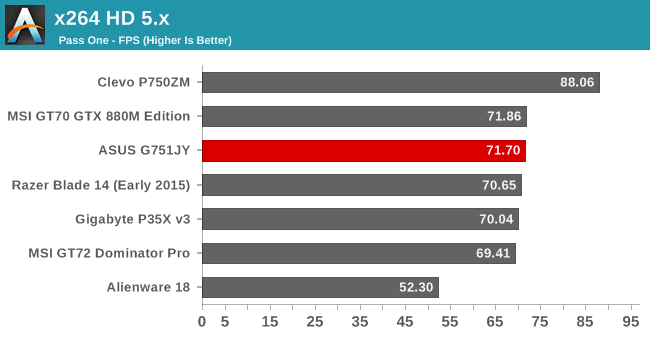
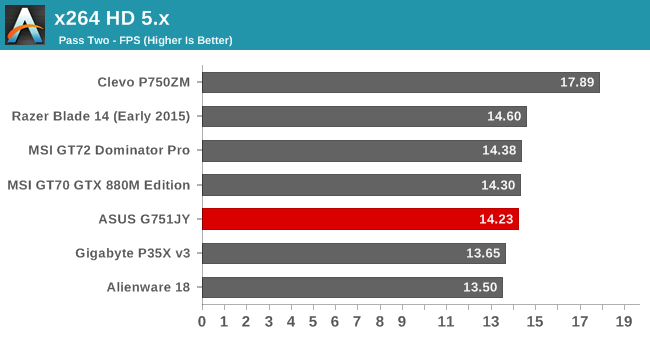
Much like Cinebench, the processor is the key to this score, and once again the i7-4720HQ performs right where you would expect it to, and the Clevo’s desktop processor once again reigns at the top.
Web Tests
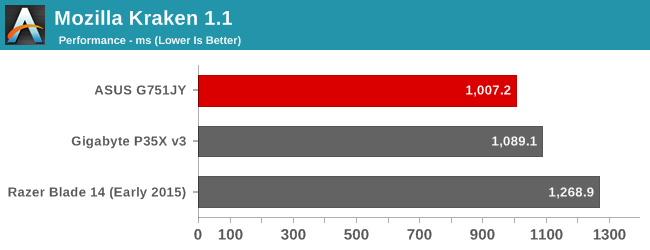
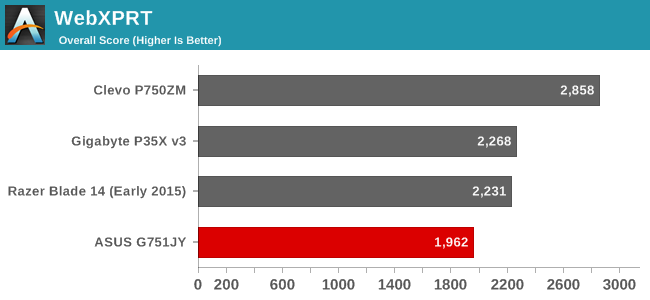
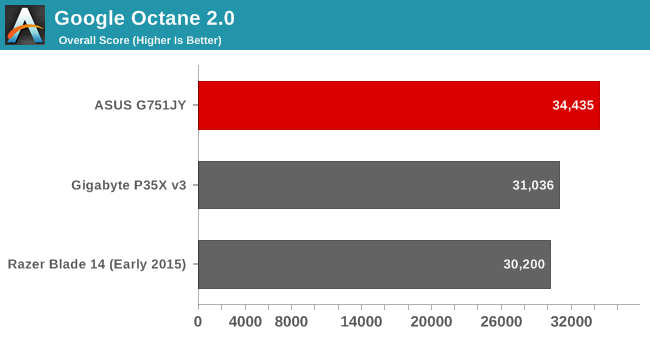
None of the laptops listed are going to struggle with web performance, but it is still handy to see where a fast quad-core system sits. The G751 performs well in the javascript benchmarks using Chrome as the browser. When Windows 10 ships, we can start to move over to Edge as the browser for our web tests.
Storage
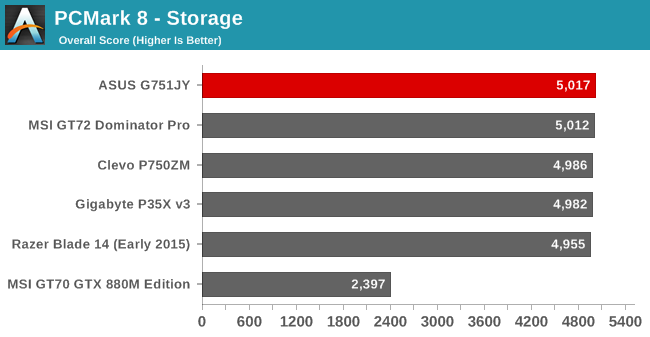
The PCMark Storage test runs traces on a couple of different workloads, but it tends to lump pretty much all SSDs fairly close together, so I’ve also added the CrystalMark Disk benchmark to give a quick glance at the speeds that the G751 can achieve with its PCIe based SSD. It’s been a while since we’ve tested a notebook with a disk based hard drive, so I thought it would be good to test the storage drive as well just so we don’t forget why we’ve moved to SSDs.



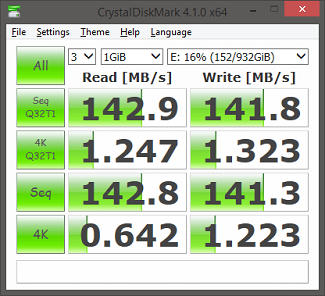








52 Comments
View All Comments
Notmyusualid - Saturday, August 1, 2015 - link
^ Also this is true.Guys in work bemoanded my M3800 purchase back in December due to only having Haswell, and supposedly Broadwell was due out any day... But a machine was required immediately.
Broadwell shipped 8 months later, and in no numbers too! I'm not ever buying a 'U' Intel cpu, so those don't count.
Turns out my instinct (likely due to places like this), was right.
BMNify - Wednesday, July 29, 2015 - link
Around the corner?? Skylake H mobile will take atleast 6 months before launching in a new product like this, people buy when they need and don't wait half a year for updates.shadowjk - Wednesday, July 29, 2015 - link
Exactly. I'm still on 4700MQ + 780M.With "Skylake around the corner", nobody seems to want to sell even the few Broadwell-H laptops that allegedly exist, atleast in Europe. I'm guessing we'll be stuck on Haswell another 9-16 months..
boeush - Wednesday, July 29, 2015 - link
My guess is, nobody wanted to invest in Broadwell H inventory, when Skylake is soon to render it obsolete. OEMs are simply waiting for Skylake to refresh their models; they are skipping Broadwell pretty much just as Intel did.Refuge - Thursday, July 30, 2015 - link
Yes, this. No OEM's are paying Broadwell much mind. It was a flubbed launch when you look at its placement in the timeline. Timing was all wrong.Intel shouldn't have even bothered with it if they weren't going to push back Skylake, but oh well. At least the limited it to a very small launch.
douglord - Wednesday, July 29, 2015 - link
Totally pointless system for anyone that's not an engineer or architect that has to be able to take 3D drawings to customers.Why can't we get a 4 Core 45w chip with Iris Pro in a 5lb 15" laptop with all day battery life (10 hours)?
No we have to choose between a pointless 10lb gayming system with 1 hour battery life and 2 core ULP garbage in a 2lb folder.
BMNify - Wednesday, July 29, 2015 - link
I doubt you even read the article's first paragraph before commenting here, You are blabering about Engineers and architects and ignoring the name of the product itself: "Republic of Gamers", Hope you got a clue and its gaming not gayming. Hope i didn't hurt your gay feelings, homophobic people generally are just hiding their own insecurities and can be cured with proper help in coming out of the closet.Notmyusualid - Saturday, August 1, 2015 - link
doug sounds clueless to me.benzosaurus - Wednesday, July 29, 2015 - link
I believe the low-end Retina Macbook Pro is exactly the machine you're describing.boeush - Wednesday, July 29, 2015 - link
As an engineer (SW) who periodically deals with 3D graphics and modeling, I wouldn't bother with any 16:9 screen no matter the resolution. 16:10 is the minimal aspect ratio that is remotely acceptable for a workstation. 1080p is only suitable for movie watching, and is counter-productive for anything else.